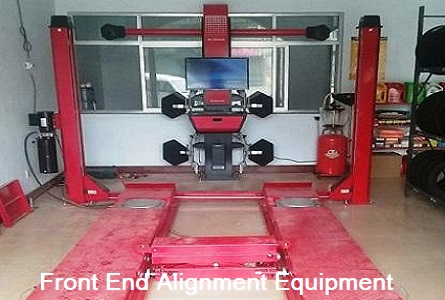
In this article we talk about the 3 main reasons you need a front end alignment. More importantly, after you review these reasons stay tuned for more information about how to avoid common automotive scams and rip-offs consumers deal with when purchasing this service.
On our sister site, we wrote a great article that discusses the cold hard truth about front end alignments. Although this valuable service becomes absolutely necessary in some situations, it provides an opportunity to take advantage of consumers. This comprehensive article includes details about what to ask the shop and how to verify additional and sometimes expensive front end alignment add-on charges are actually needed.
The Steering Wheel is Off-center

When you’re cars going straight and the steering wheel is not centered perfectly this indicates that the toe setting shifted. This often occurs when the driver slams a large pothole or even bumps one of the front tires against the curb. With that said, an impact hard enough to move this setting might also damage front and parts.
When the auto repair shop sets the vehicle up on the alignment machine the initial readings can indicate the presence of damaged steering and suspension parts. The important information to understand here is that setting the toe to factory specifications remains a quick and easy operation on most automobiles.
If no front end parts show damage and only the toe needs resetting there should be no additional charges to the base alignment fee. These basic alignment fees are often in the $50 range. However, some shops will charge a promotional price of $29.95 to get customers up on their alignment racks. If all they do is set the toe and let it go, you shouldn’t pay more than the advertised price for the basic service.
Uneven and Severely Worn Tires

Uneven tire wear remains a common issue on many automobiles. Nevertheless, this doesn’t automatically mean that you need a front end alignment. Do yourself a favor and measure the tread depth of the tires in three key locations. Take outside tread, middle and inside tread depth measurements with a tire depth gauge. These precision measuring tools cost around $6 and every car owner needs one.
Write the three measurements down and take a good look at them. If only one or 2/32 of tread depth difference shows between the three measurements we consider this normal tire wear. In fact, other automotive maintenance problems in addition to front end alignments cause uneven tire wear. Some of the most common include lack of tire rotation, bad shocks, struts or other worn front end components.
With that said, if you look at the face of the tire and there are cords showing on the inside tread yet 5/32 of tread measures on the outside location this indicates you need a front end alignment. In addition, you need more than just a tow adjustment as mentioned in the previous section. Uneven and severely worn tires often point to a camber adjustment out of factory specifications. Note that your factory auto repair manual provides these camber specifications.
A Pulling Condition Indicates a Front End Alignment Issue

One of the 3 reasons you need a front end alignment could be the way the vehicle drives down the road. If you find yourself fighting to hold the car in a specific lane on a relatively flat road mechanics call this a pulling condition. Bear in mind, that you should test this situation on several different roads to make sure that it’s the automobile and not the highway causing the issue.
Another thing to mention is they designed the automobile to go straight down the road, but not with your hands off of the wheel. It’s nice if the car goes straight for short periods when you do this, but most cars won’t. The difference between a pulling condition that needs attention and one that’s normal, might require a road test from a mechanic. All roadways have a crown built into them for proper storm drainage.
Car makers designed their automobiles to compensate for this crown. However, old roadways can shift and settle and change the amount of road crown. In the end setting the vehicle up on the alignment rack might be required to check the caster settings. Note that both caster and camber alignment angles can cause a pulling condition.
Protection from Front End Alignment Scams

Your car is up on the front end alignment rack and the auto repair center paid a lot of money for this equipment. In an effort to recover this expense they can go a little overboard with their recommendations or alignment up sells. These additions can range from replacing front end parts to performing radical adjustments.
Sometimes a mechanic will shake the front end and see a little movement in a ball and socket steering part. Note that some play is normal and this movement should be measured with a dial indicator and then compared to factory specifications. Another common up sell is elongating struck mounting holes so the shop can make camber adjustments. Often the shop will point to the uneven tire wear to validate this additional charge.
As mentioned in the second reason you need a front end alignment there’s multiple causes for uneven tire wear. If the owner fails to rotate the tires every 6,000 miles as recommended by the manufacturer they will wear unevenly. Another thing to take note of becomes the mileage on these tires. If the tires go 30,000 miles without a tire rotation they won’t look good at the end of their lifespan. Also note that some car makers install cheap tires to hold down expenses on the factory assembly line. If you try to get 50,000 miles out of a tire designed to go 25,000 miles they won’t look good at the end of their life.
